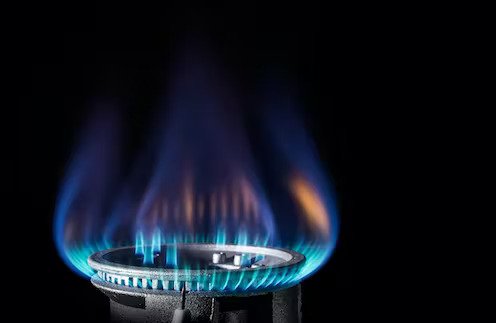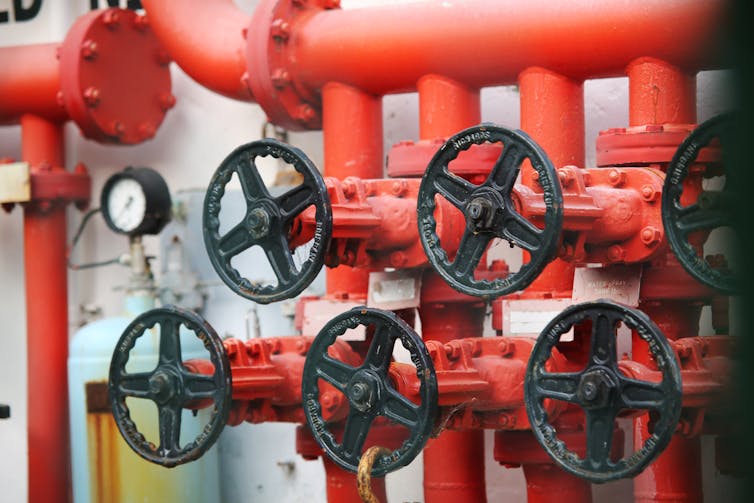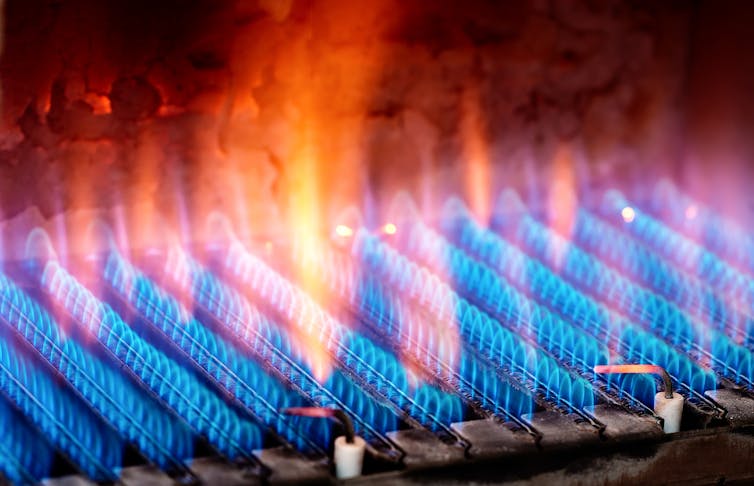To tackle the energy crisis about to send our bills skywards, the Albanese government last week capped gas prices temporarily in the east coast market, proposing a figure of A$12 per gigajoule. A gigajoule of gas has the same energy as about 26 litres of petrol.
But has the government been too generous to the three gas majors? After all, before the Ukraine war and sanctions on Russia jolted prices up, the average price gas producers were asking to supply gas next year was around $9.20 per GJ, with 96% of price offers under $12. Australia, of course, is the world leader in producing and exporting liquefied natural gas (LNG), so there’s no issue with supply.
If you look west, you’d immediately think the government’s cap is indeed too generous. Western Australia’s gas prices are roughly $5.50 per GJ. So while capping prices at $12 may stop gouging, it’s still more than we needed to be paying. And a higher cap on prices may actually encourage more greenhouse emissions, as it gives gas producers the incentive to ramp up production. Gas producers and lobby groups argue price caps will push investment away from Australia to other countries.
So who’s right? Let’s find out.
Keeping the gas flowing is a necessity for the time being. Ms S. Ann/Shutterstock
How does a price cap work?
Put simply, the $12 price cap will apply to all new contracts for wholesale gas on Australia’s east coast gas market.
It will only apply to the east coast domestic market because WA has had in place a separate domestic gas reservation policy since 2006, which requires 15% of locally produced LNG to be kept for the local market. As a result, WA has been largely protected from global price hikes this year. Gas prices have averaged between $5.50 and $6 per GJ.
After 12 months, the price cap will expire. Or will it? Once the year is up, the government will consult with industry and reassess the cap under what it has described as a “reasonable price” plan. This means the government will inspect future gas contract offers to see if the price is “reasonable” based on cost of production plus an agreed profit margin.
This suggests some form of price control will be with us for a while. Government control over energy prices – in countries that produce gas – is now imperative given the global disruptions to the market. Higher energy prices are likely to be with us for the foreseeable future and gas will continue to influence energy pricing until the renewable sector can replace it.
Did the gas majors get too much?
It depends: $12 per GJ is much more than east coast gas producers were being paid before the Ukraine war started in February. Before that, producers were still turning a profit while selling at $5-7 per GJ. This year, prices reached as high as $45 per GJ.
These prices are simply unsustainable, distorting the market and causing major disruption to domestic consumers and industry. This windfall boosted gas producers’ profits but came at significant cost for many heavy energy using industries. The government had to act.
Free market purists would say we should have let the market decide. But that would have plunged many into energy poverty, where people would be unable to afford to heat or cool their homes and many industries would have had to shut. As Rod Sims, former head of the Australian Consumer and Competition Commission, has pointed out, failing to act would not have been good for the social fabric of the community.
While alternatives like heat pumps will start to displace domestic gas use, it will be with us for a while yet. Shutterstock
Even so, intervening in the market was always going to be difficult. It’s no surprise the eastern gas companies squealed, given they have never been subjected to a price cap, a reservation policy or even had the so-called gas trigger pulled to ensure supply volumes were adequate. Producers have variously described the price cap as “reckless”, “rushed” and an “ill-considered” intrusion. If you had been raking it in, you might be miffed too.
Capping gas prices at $12 is certainly not the best pricing option. As others have pointed out, $7 per GJ would still give gas producers a significant profit and could help us cut our greenhouse gas emissions.
But bear in mind this price cap was always intended as a first-base plan, allowing the government to act quickly to keep energy prices from ballooning. It would have been a very difficult year if the government had not done this – especially as voters are fully aware they live in a country with an abundant supply of gas.
Because this is the first time gas contracts on the east coast have been subjected to a price cap, the government had to act cautiously. That’s why it gave gas producers more than $7, to keep them on side.
It’s far better we pay $12 for gas rather than the $26 per GJ gas producers were making on the spot market last quarter. In the longer term, the goal is to fend off the forecast price hike of 56% over the next 18 months.
So, we should see this as a two-part plan. First, stop prices soaring into the stratosphere immediately. And second, tackle distorted energy prices in the medium term by introducing reasonable profit rules after that, ensuring producers can make reasonable profits without subjecting consumers to the wild excesses of the global market.
You might wonder – why are we doubling down on fossil fuels? Certainly, we have to phase out fossil fuels to fend off the worst of climate change. But right now, Australia is not as far along as it needs to be in shifting to clean energy. If we want to accelerate this shift, we could look once again at pricing greenhouse gas pollution rather than hoping price caps will do the work indirectly.
What about the fact that gas is still much cheaper in WA? Why can’t east coast residents match this? Well, the reservation policy in WA has been in place for nearly 17 years, and the gas price reflects this long-term framework.
Over east, this $12 price cap captures what Treasurer Jim Chalmers describes as the need to balance support for the east coast gas sector while preventing a disrupted global market from hollowing out local industries and adding yet more strain to struggling families.
How should we see this cap?
If you’d floated the idea of direct government intervention in the gas market a year ago, you’d have got a sceptical response. Governments messing with markets is usually controversial. That’s why we’ve seen strong pushback. But the government could not have let things keep going as they were. It was politically and socially unacceptable.
The price cap is a reasonable short-term approach. Producers will keep banking significant profits, and consumers will be better protected from huge energy market volatility. This cap gets the ball rolling. But it’s not the end of government directing markets. These are not ordinary times.



 Hong Kong Home Prices Rise for Sixth Straight Month as Rate Cuts Lift Market Sentiment
Hong Kong Home Prices Rise for Sixth Straight Month as Rate Cuts Lift Market Sentiment  Oil Prices Rise as Middle East Tensions and Ukraine Uncertainty Fuel Supply Concerns
Oil Prices Rise as Middle East Tensions and Ukraine Uncertainty Fuel Supply Concerns  Platinum Surges to Record High as Supply Crunch and Policy Shift Drive Historic Rally
Platinum Surges to Record High as Supply Crunch and Policy Shift Drive Historic Rally  Russian Stocks End Lower as Energy and Mining Shares Weigh on MOEX Index
Russian Stocks End Lower as Energy and Mining Shares Weigh on MOEX Index  China Revises 2024 GDP Lower After Final Review, Eyes Growth in 2025
China Revises 2024 GDP Lower After Final Review, Eyes Growth in 2025  Taiwan Stock Market Ends Higher as Semiconductor and Energy Shares Lead Gains
Taiwan Stock Market Ends Higher as Semiconductor and Energy Shares Lead Gains  Japan to Audit Brazil’s Beef System, Paving Way for Market Access
Japan to Audit Brazil’s Beef System, Paving Way for Market Access  Tokyo Core Inflation Stays Above BOJ Target, Strengthening Case for Further Rate Hikes
Tokyo Core Inflation Stays Above BOJ Target, Strengthening Case for Further Rate Hikes  BOJ Signals Further Rate Hikes as Inflation and Weak Yen Remain in Focus
BOJ Signals Further Rate Hikes as Inflation and Weak Yen Remain in Focus  Asian Stocks Rally as Fed Rate Cut Bets Weigh on Dollar and Fuel Precious Metals Surge
Asian Stocks Rally as Fed Rate Cut Bets Weigh on Dollar and Fuel Precious Metals Surge  U.S. Stock Futures Edge Higher as Holiday-Thinned Trading Persists
U.S. Stock Futures Edge Higher as Holiday-Thinned Trading Persists  Russian Stocks End Mixed as MOEX Index Closes Flat Amid Commodity Volatility
Russian Stocks End Mixed as MOEX Index Closes Flat Amid Commodity Volatility  Oil Prices Hold Steady in Asia as Geopolitical Tensions Support Market
Oil Prices Hold Steady in Asia as Geopolitical Tensions Support Market  Asian Stock Markets Trade Narrowly as Year-End Volumes Thin, KOSPI Outperforms on Tech Rally
Asian Stock Markets Trade Narrowly as Year-End Volumes Thin, KOSPI Outperforms on Tech Rally  Japan Approves Record ¥122.3 Trillion Budget as Takaichi Seeks Fiscal Balance
Japan Approves Record ¥122.3 Trillion Budget as Takaichi Seeks Fiscal Balance  China’s Central Bank to Launch New Digital Yuan Management Framework from January 1
China’s Central Bank to Launch New Digital Yuan Management Framework from January 1  U.S. Stocks Hold Steady After Christmas as Trading Volumes Stay Light
U.S. Stocks Hold Steady After Christmas as Trading Volumes Stay Light 
































